No two families start exactly the same. In some sense, every decision to have children involves a leap of faith. Nothing in this world is a guarantee; as plenty of parents have learned, there is much that can go wrong during a baby’s formative nine months in the womb and truly, through their entire lives, this world can be a treacherous place.
Our adoption story actually started long before we met. As young adults, we both separately believed that adoption would be a part of our stories. There was something so beautiful and redemptive in turning an orphan into your beloved child. Every adoption story, without a doubt, starts with tragedy and loss. Even if the biological parents enter the process without their own painful story, the fact is that every orphan has experienced loss. Whether their story involves abuse, neglect, abandonment, or the death of parents, every orphan must face their own hard things.
While we were dating, we learned that Sarah carried an X-linked genetic condition called Myotubular Myopathy. It is a swift, brutal neuromuscular disease that results in very poor muscle tone. While the disease varies in severity, our version is the most severe. It results in death within the first few years of life, and usually much less. Sarah had already lost a nephew and a brother to the disease.
As we began our journey toward parenthood, we knew that we could potentially lose a child; yet we decided to go boldly forward in faith. In 2014, we gave birth to our firstborn son, Daniel Thomas. Daniel’s entry into our world did not go smoothly. Sarah’s water broke as Daniel was only 30 weeks along, and within a few minutes we were in the back of an ambulance with wailing sirens. A very short time later, after Sarah’s emergency C-section, our handsome yet remarkably tiny son Daniel Thomas entered the world.
Despite his dramatic start to life, it wasn’t immediately clear that Daniel was sick. Yet, after a series of discouraging setbacks, we learned that he indeed carried the disease that years earlier took the life of his uncle and his cousin. After 27 short, heartbreaking yet wonderful, days we said goodbye to our sweet little man. Our world was turned upside down, and we struggled with figuring out our next steps.
Sarah’s heart turned to adoption much faster. She asked God to make her heart more like His and guide us, spending hours looking at waiting children and praying over them. However, I struggled to similarly to open my heart. I struggled initially with anger and bitterness, and had a hard time trusting God. However, with time, I learned to take small steps of faith, and eventually became thoroughly excited at the prospect of international adoption.
Slowly through prayer and investigation we landed on China’s Waiting Children. After burying a child we were a bit cautious, so we marked a handful of minor, correctable needs and waited. Then just three weeks after becoming logged in, we received that momentous phone call. It was a boy! But his medical need wasn’t on our medical conditions checklist – turns out, it’s not on anyone’s MCC! He was 18 months, cute as a button, and it said on his medical report that he was born without a left eyeball. Honestly, our first reaction was to be freaked out and overwhelmed. It wasn’t what we were planning on, as if we could control the entire adoption process. Then, we received the email with his file. As the first picture loaded, it was love at first sight.
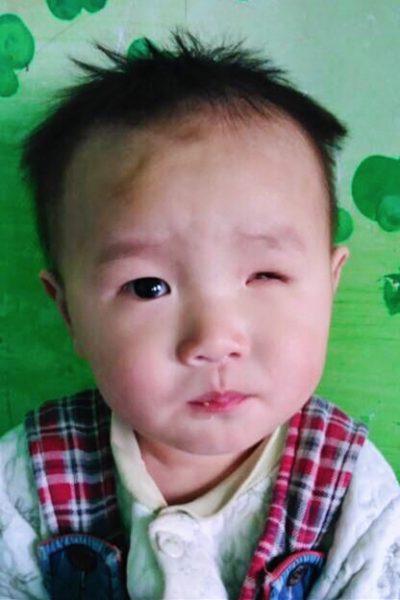
We plowed ahead with a furious pace of research and phone calls.
What would the process of getting a prosthetic eye look like?
How could we afford it?
A sober assessment from an adoption doctor nearly dissuaded us; some unanswered questions from his first few weeks of life left us in a state of uncertainty and panic.
What if this wasn’t the right child for us?
Are we throwing our lives away?
Are we the wrong parents for him?
The doctor’s words ended on a note of caution: accepting this child’s file would mean taking an enormous leap of faith.
As we wrestled, prayed, and consulted wise counsel, we were reminded by another doctor, who had kindly offered a second opinion: Every child is a leap of faith.
Every single one, whether biological or adopted, involves big, unanswerable questions. We should know; we did, after all, bury a biological son. We made the decision to accept this child. Come what may, regardless of brain damage or speech and developmental delays, he would be ours and ours alone.
In total, we had about four days to make this decision. Tom likens it to progressing from first date to engagement in four days, and without even meeting him in person! Adoption is, after all, just as big a commitment as marriage.
We said “Yes”!
We spent the next few months preparing for our new lives as a family and for our trip. With a step of faith, we boarded a plane for China and, a few days later, met Theodore Thomas.
We found ourselves in Zhengzhou, holding our son for the first time, all fears swept away by the pure joy of knowing he was now ours. On day one, we felt so lucky: our son was active, healthy and full of life. He quickly learned to adapt to new environments, and we didn’t perceive any significant difficulties with his depth perception or overall vision.
We were amazed by how quickly he learned and by how developmentally on target he was. We are deeply grateful for his caregivers in China, who shed more than a few tears when they said goodbye.
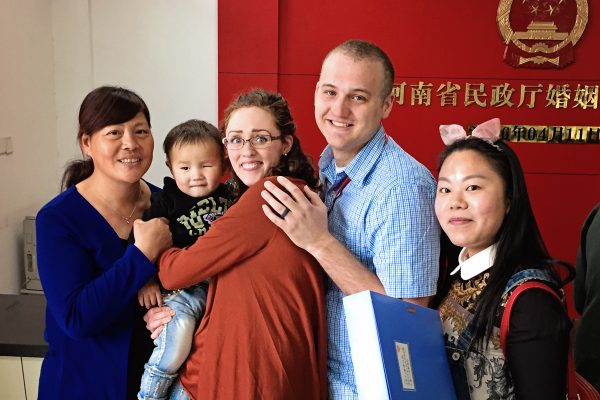
There are many things about international adoption that are challenging. It’s hard to meet your child, who doesn’t speak the same language, in a foreign country that is unfamiliar to you. We needed help deciphering the labels on the formula packages, and even needed help navigating the grocery store. Chasing a toddler around a classy hotel with marble floors made me long for our carpeted living room with baby gates. Yet, despite the challenges, we had a lot of help.
Our agency, was instrumental both in helping us prepare for the trip and navigating the challenges we encountered while in the country. Additionally, the Chinese people we encountered were all very helpful, including the hotel employees, the government agency representatives, and the staff from the orphanage.
Perhaps the most unexpected source of support came from the other adoptive parents in our travel group. There were 12 other families in China with us, and they were a tremendous source of knowledge, support, and comfort. Some of us were new to parenting while others were veterans, but we forged a lifelong bond as we met our new children and watched each other’s families grow before our eyes.
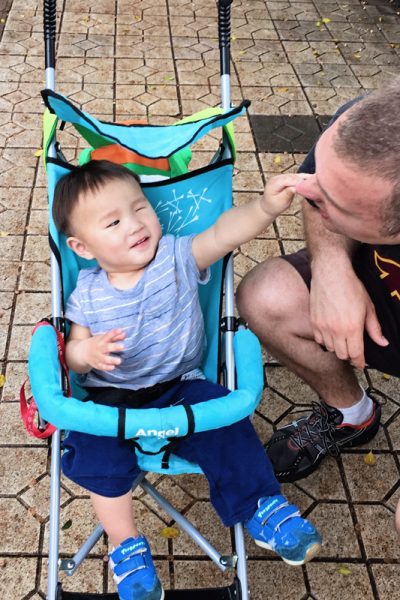
Completing any international adoption, especially one involving a special need, involves a flurry of doctors appointments. After coming home, we started with an appointment at the adoption clinic that’s affiliated with our local university. Teddy was evaluated by several experienced physicians, an occupational therapist, and a psychologist who evaluated his attachment. Overall, they confirmed our initial assessment – Teddy was a healthy toddler who was developing quite well considering his time in an orphanage. During the assessment, Teddy heaved a weighted ball effortlessly across the room, scoring himself a satisfactory physical assessment and giving Dad a bruise on the leg!
In the beginning, it felt as though every appointment completed led to three more specialist appointments, and our calendar began to fill very quickly! Yet, as we made progress through investigating his missing eye, on getting him caught up on routine vaccinations, and performing the typical childhood examinations, he has been a trooper.
Teddy’s eye surgeon has been a particularly positive voice. Medical professionals sometimes get lost in the detail, particularly when they are just learning the profession. At our first visit, a series of residents and doctors asked a flurry of questions, and did a fair share of poking and prodding. Just as Teddy was about to lose it, the main ocular surgeon arrived. He recognized our son’s impatience and kneeled down with him on the floor. He took a peek in his eye socket, gave us his opinion, and very succinctly explained the process going forward. His calm, professional demeanor has been a significant calming presence during this process, and midway through our son’s surgeries… it just doesn’t feel like a big deal anymore.
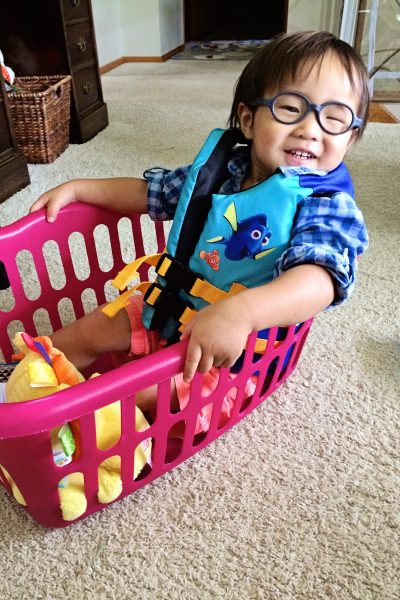
During the initial phase of his eye appointments, we also learned that Teddy didn’t have anopthalmia, or the absence of an eye. Rather, he had a tiny, ineffective eye, called micropthalmia. This tiny eye didn’t do anything so the difference wasn’t really profound. The main difference is that the other structures of the eye, including muscles and tear ducts, are more likely to be correctly formed in cases of micropthalmia than anopthalmia.
Before we began, they gave Teddy an MRI to determine the shape of the socket and identify any complications before beginning the process. The surgeries involve placing a series of gel-like conformers. The conformers stay in the eye socket on their own, and grow gradually by absorbing tears. Once they have reached maximum growth, Teddy goes in under sedation and has his conformer exchanged for a larger one, usually after a few months. The first surgery included removal of some bits of eye tissue that never properly developed. In all, the actual surgery only takes 5-10 minutes per session.
In preparation for the last surgery, our surgeon worked with an ocularist – part medical professional, part artist. Ocularists craft ocular prosthetics and provide ongoing support and service for their patients. Once the last conformer is ready to come out, the surgeon will take a piece of belly fat and place it in the eye socket. It will grow with him and help the provide the needed pressure to keep the eye socket in the proper shape. Then, Teddy’s eye socket is ready to accept the prosthetic, and it’s likely he’ll be visually indistinguishable from children who have two natural eyes.
It’s hard to turn your son over to others for surgery, and even harder to watch him struggle with the confusion that accompanies sedation. Yet, we feel so blessed to have such a great medical team that cares for us on during these difficult days. After a few difficult hours, our son is back to himself. We always worried about surgeries and other medical procedures being traumatizing enough to affect his attachment to us. Besides a little insecurity and a few nights of disturbed sleep patterns, he always bounces back. He amazes us.
For children with only one effective eye, doctors strongly encourage protective eyewear. Without the redundancy of two eyes, the loss of his good eye would mean permanent blindness. Teddy wears glasses for protection and a slight astigmatism that was found in his right eye. Honestly, the fitting was the worst part of it. We talked about the glasses for weeks – he calls them “goggles”! When they finally arrived, he was ecstatic at the chance to wear them and rarely takes them off. In fact, he gets irritated when Daddy wears contacts instead of glasses.
We aren’t finished taking leaps of faith. Although concerns of brain damage or speech delays are put to rest, MRI scans did reveal a Chiari 1 malformation. This is a malformed bone in the base of his skull. This diagnosis can mean many things. It could resolve completely on its own, it could result in headaches managed with medication, or it could require surgery on the bone that touches the base of his brain. It’s scary, especially for parents like us who know how badly things can go. Yet, how boring would life be, and parenting, without the continual need to take leaps of faith?
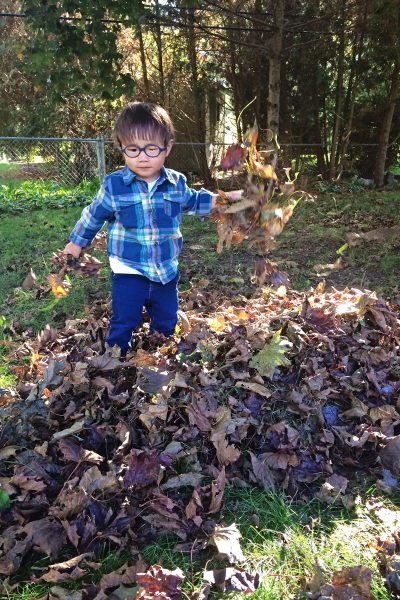
As any adoptive family can attest, most people put you on a pedestal when they hear that you’ve adopted…
“What a lucky little boy.”
“You guys are such great people to do something like that.”
We never quite know how to address their comments. We don’t want to be offensive and, on some level, do recognize the remarkable opportunities that are now his. However, we can’t ignore the absolutely astounding gift that we have received.
We, who mourned with empty arms, now have a home full of laughter and joy.
Teddy will never replace Daniel, but he’s not supposed to. We are parents again; we get to watch Teddy learn and grow and flourish, and we get to revel in the hugs and kisses and unconditional love he gives us.
We don’t know what tomorrow brings, but when I look at my son’s joyful face, I know we’ll find the strength to face it together, as a family.
– guest post by Tom and Sarah Nerison

























Heartbreaking, beautiful, and inspiring….
We always answer the “your kids are so blessed” with “You know, THEY are the blessing and we just hope we bless them as much as they’ve blessed us.”
Thank you for sharing the beautiful journey you’ve walked with God.
Our daughter was born without her right eye. We adopted her from China in 2013 when she was just 18 months old. Because this is such a rare condition, it is encouraging and comforting to find another family dealing with the same struggles.
As one of those “veteran” parents on your trip, we couldn’t be more encouraged by your obedience and step of faith towards your son. What a testimony of God’s grace!
Thank you for sharing this story. Our stories are inside God’s story, His grand story and grand plan for our lives. We love you, I love you so much. Thank you again for sharing, it makes a difference for me to know what is going and and know how to best support you.